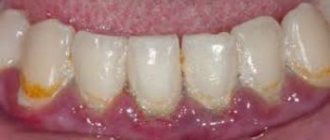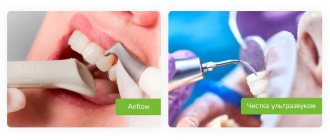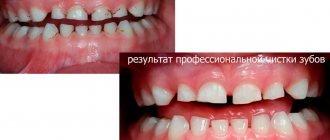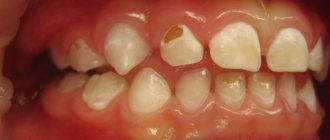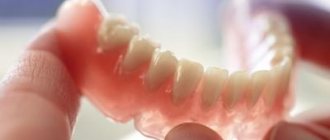Food debris, accumulations of bacteria and saliva form a film that tightly adheres to the enamel, tongue, gum edge and even orthodontic structures. This film is plaque and is called dental plaque. It is impossible to prevent its formation. Within a few minutes after cleaning, plaque begins to form again. In the absence of daily hygiene, the film gradually hardens with the formation of tartar. But even proper regular brushing of teeth does not always prevent the appearance of deposits.
Dentists at the Nurimed clinic will conduct a professional examination of the oral cavity, determine the causes of plaque formation and help get rid of it using innovative technologies and modern equipment. You can make an appointment by phone or by using the feedback form.
Causes of plaque on teeth
The main risk factors for deposit formation are:
- Lack of oral hygiene;
- Incorrect selection of cleaning products;
- Excessive consumption of simple carbohydrates (sweets, baked goods, carbonated drinks, sugar, etc.);
- Predominance of soft foods in the diet, lack of hard foods;
- Drinking coloring drinks, including coffee and tea;
- The presence of fillings, dentures, braces and other orthodontic structures;
- Chips, cracks and other damage to the dentofacial apparatus;
- Smoking;
- Individual properties of saliva;
- Intensity of chewing food;
- Diseases of the gastrointestinal tract;
- Diseases with metabolic disorders;
- Congenital and acquired defects or anomalies of the dentofacial apparatus;
- Long-term treatment with antibacterial drugs.
Another reason why plaque appears can be improper brushing of teeth. Oral hygiene should include not only the front surface of the teeth, but also the back, as well as the tongue. Hard-to-reach spaces can be cleaned using thread.
Professional Air Flow cleaning
This method is considered the most gentle on enamel and painless. The essence of the procedure is to influence deposits with a mixture of water, air and soda crystals, which is supplied under pressure. This way you can clean your teeth and the spaces between them.
The dentist recommends Air Flow cleaning to the patient in the following cases:
- the presence of plaque that turns into stone;
- discoloration of enamel caused by drinking strong tea, coffee, carbonated drinks, smoking;
- if it is necessary to install or remove crowns, braces, implants, high-quality cleaning of these systems;
- the presence of tightly spaced, twisted teeth in a row;
- the appearance of symptoms of periodontal disease.
Timely cleaning with such a device helps prevent the development of caries, gingivitis, periodontitis and periodontal disease. It allows you to effectively remove deposits on teeth, between units, even in the most inaccessible places, as well as on dental structures. At the same time, the enamel becomes lighter by 1-2 tones, pigment spots disappear. During polishing, the enamel is saturated with fluoride and strengthened.
Despite all the advantages of Air Flow, this procedure has a number of contraindications. In particular, it is not carried out when:
- severe pathologies of the respiratory system, including bronchial asthma;
- hepatitis;
- diabetes mellitus;
- tuberculosis;
- tendency to allergic reactions;
- HIV;
- infectious diseases;
- heart rhythm disturbances, presence of a pacemaker;
- increased sensitivity of enamel;
- the presence of areas of demineralization;
- installed titanium implants.
This method of professional cleaning is not recommended during pregnancy and lactation.
After the procedure, for 2-3 days the patient may complain of pain when eating cold and hot food. To reduce enamel sensitivity, you must use toothpaste labeled “Sensitive.” Be sure to buy a new brush with soft bristles.
During this period, it is better to exclude sour and sweet foods, cold and hot foods from the diet, refuse to drink carbonated drinks with dyes (including low-alcohol ones), coffee, strong black tea, and red wine. It is undesirable to eat red and orange fruits and vegetables.
How is plaque formed?
First, soft plaque forms on the teeth, the formation of which consists of three stages:
- A couple of minutes after the end of cleaning the oral cavity, active reproduction and spread of bacteria throughout the oral cavity begins. The process takes 4 hours, after which the number of bacteria reaches a million.
- Over the next 3 hours, the bacteria attach to the surface of the tooth enamel and form a soft film. After fixation, microorganisms begin to release substances that destroy the enamel, causing carious lesions to develop.
- When 8 hours have passed after cleansing the oral cavity, deposits become visible and structured. The majority of bacteria in them do not require oxygen.
The resulting film progressively thickens and becomes denser. hard plaque forms within a day after the last brushing. The formation of tartar is typical for surfaces that have little contact with the tongue and food.
Kinds
Let's look at the types of plaque on teeth:
| Classification | Description |
| Bacterial | Characterized by a soft, loose consistency. The presence of many specific bacteria is noted in the plaque. It can be easily removed from the tooth surface with a simple toothbrush. It is localized mainly in the cervical area of the tooth. Bacterial plaque may have a hard consistency. It is not removed by brushing your teeth. It is called bacterial stone. It is formed under the influence of calcium and phosphorus salts contained in saliva on soft microbial plaque. The cause of plaque is insufficient hygienic treatment of the oral cavity or its complete absence. If hygiene standards are violated, bacteria quickly grow and multiply, mainly immediately after eating. Their accumulation forms plaque near the necks and on the borders of the teeth. |
| Pigmentary | The reason for the appearance of this plaque in adults is the presence of polyphenolic compounds contained in tobacco, coffee beans, tea leaves and some foods. If hygiene habits are violated, pigmentation on the teeth, stones and bacterial plaque are immediately noticeable. Black pigmentation develops quickly in adults who do not brush their teeth. In this regard, pigment elements easily stick to the surface of the tooth on which there is bacterial plaque or stone. It is more difficult for pigments to stick to clean, smooth enamel. |
What kind of raid is there?
Dark enamel
The main risk factors for the formation of dark-colored deposits:
- Dysbacteriosis in childhood;
- Hypoplasia of teeth, often of a congenital nature, in children;
- Smoking, consumption of coloring products;
- Deficiency of salivation;
- Disorders of calcium, vitamin D, and phosphorus metabolism.
There is no way to get rid of this problem at home. Increasing the intensity of cleaning will only worsen the situation. It is necessary to eliminate the original cause. Adults are often offered cosmetic correction with veneers.
Black plaque on teeth
The formation of black deposits in childhood is caused by problems with the digestive system, helminthic infestations or fungal infection of the oral cavity.
In adults, risk factors are:
- Alcohol abuse, smoking, drug addiction;
- Long-term (more than 2 weeks) use of antibacterial agents;
- Severe somatic pathologies (decompensated liver disease, dysfunction of the spleen, and so on);
- Change in pH in the mouth;
- Working with metals (harmful working conditions);
- Copper products in the oral cavity;
- Diseases of the endocrine system;
- Allergies;
- Parasitic infections;
- Chemotherapy treatment.
The black tint cannot be removed with special whitening pastes, so instead of wasting money, it is better to immediately contact Nurimed dentists.
Yellow film
Normal enamel has different shades of yellow. The natural yellowness of the teeth is inherited. In addition, an excess of various minerals in the diet is also a common cause of yellowing of the enamel.
Causes of yellow plaque on teeth near the gums:
- Bad habits, consumption of coloring products;
- Excess of sweets in the diet;
- Frequent changes in diet and diet;
- Mechanical damage to the dentofacial apparatus;
- Lack of personal hygiene;
- Wearing braces without proper care;
- Age-related changes in enamel color.
At the initial stages, you can deal with yellow deposits on your own. However, it is recommended to consult a dentist to ensure that cleansing does not damage the enamel.
White deposits
White plaque on teeth is most common. These deposits form on tooth enamel every day and must be brushed off with a toothbrush. Otherwise, the film hardens with the formation of tartar.
Additional risk factors:
- Hypovitaminosis;
- Poor nutrition;
- Lack of solid foods (especially in children);
- Improper cleaning of the mouth.
If daily care does not help completely get rid of the white film, consult your dentist. The doctor will determine the optimal cleansing algorithm and give recommendations.
Brown plaque on teeth
It often develops in smokers, coffee and black tea drinkers. Additional reasons for education:
- Rinse mouth with manganese solution;
- Impact of iodine, chlorine on enamel;
- Ingestion of vapors of mercury, iron, manganese, nickel, lead;
- Rh conflict during pregnancy (destruction of red blood cells).
Fixing the problem on your own is almost impossible. An important stage of the fight is identifying the cause followed by treatment.
Coffee stains on teeth
Drinking coffee leads to the formation of a persistent dark film on the enamel. Without special cleaning methods, deposits cannot be removed.
The following measures will help reduce the intensity of color changes:
- Reducing the amount of coffee you drink;
- Increasing the amount of vegetables and fruits in the diet;
- Use of whitening pastes;
- Use of rinses.
Regular professional teeth cleaning will help keep your teeth beautiful and healthy.
Smoker's plaque
Plaque on teeth from smoking is a specific discoloration of the enamel that is difficult to get rid of. The following signs help to distinguish it from deposits of other origin:
- Soft tissues of the mouth without signs of inflammation;
- Darkening of the enamel begins from the cervical area;
- The presence of a putrid odor;
- Gums are pale pink.
Ignoring the deposition of resins in the oral cavity leads to the development of inflammatory processes and persistent bad breath.
Consumption of certain foods and drinks
Black plaque as in the photo often appears in those people who love strong tea and coffee without milk, red wine, Coca-Cola, dark chocolate, currants, blueberries, and pomegranates. The fact is that these products contain a large amount of dyes and polyphenols, which color the enamel in an unpleasant dark shade. Polyphenols are powerful antioxidants, but frequent consumption of foods rich in these substances and lack of basic oral hygiene after eating and drinking play a cruel joke on some people.
The photo shows stains from tea and coffee
If you do not want your teeth to become covered with black plaque, then after eating food and drinks, do not forget to thoroughly rinse your mouth with water or mouthwash. In the evening and morning, be sure to clean with paste, brush, floss and irrigator. If the pigment does appear, then a complex of professional hygiene at the dentist will help to cope with it.
We must also not forget that some of these foods and drinks (coffee, sweet carbonated drinks, berries) have high acidity, due to which the enamel becomes more porous and rough, which means that any pigment penetrates into it more easily.
How to get rid of plaque on teeth?
If you notice a change in the color of the tooth surface, it is recommended to consult a dentist to combat it. The doctor will be able to accurately determine its cause, then carry out professional cleaning with minimal risk of complications. However, in the initial stages, plaque removal on teeth can be done at home if you follow practice-tested recommendations.
How to remove plaque at home?
Deposits, regardless of the cause of their appearance, cause aesthetic discomfort. Before turning the soft film into hard stone, you can try to get rid of it at home. The following methods are used to treat dental plaque at home
- Using an irrigator. The device helps thoroughly remove food debris and thin film using a directed stream of water. The irrigator helps to clean even places that are difficult to reach with a toothbrush, such as the spaces between the teeth.
- Baking soda. The technique is suitable for one-time use, since soda with frequent use has a negative effect on the condition of the enamel. To clean, you need to dilute the baking soda with a small amount of water to form a paste, and then gently brush your teeth with it.
- A solution of salt and soda. The product is used as a mouth rinse before regular brushing with regular toothpaste. To do this, a small amount of soda and water is diluted in warm boiled water.
- Hydrogen peroxide. The product is also suitable for one-time use. Peroxide 3% is added to water, and then the surface of the enamel is wiped with a cotton pad soaked in it.
Not all types of deposits can be cleaned at home, so it is recommended to contact a professional dental clinic.
Professional removal
Contacting dentistry is the best solution for the formation of plaque and tartar. The Nurimed Clinic offers modern methods to eliminate the problem, which have a gentle effect on the enamel, but effectively remove deposits. In modern dentistry, the following methods of combating plaque are used:
Using a laser. This is a relatively recent technology that is highly effective and has no contraindications. The price of this technique corresponds to the results obtained. Laser technology allows not only to effectively remove deposits without causing negative effects, but also to successfully get rid of pathogenic microorganisms.
Ultrasound technique. An ultrasound machine is used to direct waves to dental plaque. The deposits are peeled off and the enamel becomes smoother. The latter factor prevents bacteria from firmly attaching, so the cleaning effect lasts longer.
Air abrasive technology. Special equipment is used that directs microparticles of a special powder onto the teeth to soften plaque, water and air. Plaque is effectively peeled off from the enamel.
Isolated removal of deposits without identifying the cause of their active formation will not eliminate the problem. If the enamel darkens due to external factors, additional lightening techniques must be used. For example, removing dark plaque from cigarettes on teeth is a rather complicated procedure, the effect of which will not last long if you continue to smoke.
Contacting qualified dentists at the Nurimed clinic guarantees a comprehensive approach to the problem of changes in enamel color and the formation of deposits.
If the tooth has darkened
If one tooth has darkened and this is not a superficial plaque, but a change in the color of the tooth enamel, this means that we are talking about the death of the dental nerve and damage to the pulp. Perhaps the nerve was killed or removed during dental treatment, or the patient was in no hurry to see a doctor during an acute inflammatory process that led to the death of the nerve. Be that as it may, if a tooth is blackened from the inside, it means that only intra-canal whitening, installation of a crown or veneer will help it. In this case, the dentist must first find out why the tooth turned black and rule out the inflammatory process.
As a rule, an experienced specialist, when treating a tooth with nerve removal, knows that it will change color and immediately advises the patient to think about installing a crown or veneer. Therefore, if you don’t know exactly why your tooth turns black, remember if your doctor warned you about the possibility of such consequences.
Sometimes the reason a patient goes to the dentist is that the tooth has turned black under the filling. In this case, the cause of the tooth discoloration is most likely due to poor quality treatment. In particular, the filling may turn black if blood gets into it during installation - for example, because the doctor injured the gum. Also, a tooth under a filling may turn black if the dentist has not completely removed the damaged tooth and the carious process continues under the filling. In this case, the filling will have to be removed and a new one installed. This is a good reason to think about the professionalism of the doctor who performed the dental treatment.
In any case, the first thing to do if a tooth has turned black is to contact a reliable, highly qualified dentist.
Prevention
The formation of deposits on enamel is a physiological process that cannot be eliminated completely. However, there are general rules to reduce the intensity of its formation and minimize pathological consequences. These include:
- Personal hygiene. You should brush your teeth at least twice every day. In this case, you need to follow the cleaning rules recommended by dentists in order to get rid of the maximum amount of food debris and bacteria.
- Correct selection of paste and brush. Choosing the right teeth cleaning tools matters more than many people think. The brush should not injure the gums. It needs to be changed every 3 months. The paste is selected according to age.
- Using dental floss and mouthwash. Dental floss allows you to get rid of food debris and deposits in the spaces between the teeth. The rinse has a beneficial effect on the condition of the enamel and promotes the normal functioning of the gums. It can be used after meals to reduce the amount of bacteria in the mouth.
- Timely treatment. Diseases of the oral cavity, gastrointestinal tract, and other systems must be treated promptly and correctly. Self-medication can only aggravate the situation and lead to complications.
- Proper care. Orthodontic structures in the oral cavity require separate cleaning and care. Ignoring this factor not only leads to increased formation of deposits, but can also cause the development of an inflammatory process.
- To give up smoking. A bad habit negatively affects the entire body.
- Avoiding excessive consumption of coffee, tea, and coloring drinks.
Every person should have their teeth professionally cleaned once a year to remove tartar and hard deposits on the enamel. This allows you not only to improve the appearance of your teeth, but also to prevent a number of oral diseases. The reason why you should contact Nurimed is an individual approach to each client’s problem followed by a comprehensive solution.
Abuse of chlorhexidine-based mouthwashes
Teeth inevitably become covered with black plaque if you rinse your mouth with Chlorhexidine or rinses that contain this medicinal substance for a long time. Chlorhexidine fights bacteria and viruses well, helps eliminate the inflammatory process in the mucous membrane, helps damaged tissues recover faster, reduces bleeding gums, but it cannot be used for longer than 10–14 days in a row.
The enamel can also darken due to the abuse of rinses that contain benzalkonium chloride, as well as essential oils. Products with such components are not suitable for daily use. They are used only in courses and according to indications, for example, in complex therapy for the treatment of gingivitis or periodontitis.
Should I remove plaque at home or at the dentist?
It is difficult to call a person with black teeth beautiful. Such a defect can disrupt a person’s psycho-emotional balance, making him insecure and uncommunicative. Therefore, anyone faced with this problem will try to solve it by any means.
It is very difficult to get rid of such a problem on your own.
If you don’t have enough time to visit the dentist, and plaque forms regularly, then it makes sense to resort to removing it at home. This can be done if it is soft and loose. In this case, high-quality teeth cleaning should help.
Smokers need to use toothpastes that can break down hard layers of deposits and whiten enamel.
Important! The best way out would be to visit a dentist or go to a clinic for treatment.
About toothbrushes
Special toothbrushes will help remove dark plaque. The following types have proven themselves well.
Ultrasonic - they work on a special generator that produces vibrations. Their range is approximately 1.6 MHz. The waves act on the junction of dental plaque and enamel. This brush gets rid of darkening of the enamel and small supragingival tartar.
- Black teeth in children
Electric - these brushes are equipped with a working head on which the bristles are located. Its rotation and pulsations destroy the strong connection of pigment and mineral-bacterial layers on the surface of the enamel. And rotational movements help remove it.
Special brushes will help get rid of plaque
Eliminating black plaque with folk remedies
The use of traditional methods for removing black plaque is based on regulating the activity of pathogenic microflora in the mouth. Therefore, many home remedies work due to their antimicrobial and anti-inflammatory properties.
You can also remove plaque with the help of folk remedies.
Types of Home Remedies
Such remedies can only help in untreated cases.
A product made from activated carbon and 3% hydrogen peroxide . A paste is made from these ingredients, then rubbed over the surface of the tooth enamel using a toothbrush. Hydrogen peroxide serves as a bleaching agent, and charcoal acts as an abrasive. The product must be used very carefully, otherwise you can injure tooth enamel.
A decoction of bean husks and burdock root. The components are taken dry in a 1:1 ratio. A tablespoon of the mixture is boiled for 5 minutes, and then left for about 20 hours. Every time after eating, you need to rinse your mouth with 1 tbsp. l. decoction You also need to consume 2 tbsp. l. inside. Treatment is carried out for 2 weeks.
Use a variety of herbs and plants
Black radish remedy . A hole is made in the vegetable, honey is added inside, then left in the refrigerator for a day. After meals (3 times a day), fill a tablespoon with honey and radish shavings and chew well. The product inhibits the activity of bacteria, their waste products are removed. A side effect of the drug is the dilution of bronchial secretions and stimulation of salivation. You need to undergo treatment for six months.
Honey water and soda . One tablespoon of honey is diluted in 100 ml of water. You should rinse your mouth with this solution every time after eating. 1-2 rinses are carried out at a time. Along with this, you need to clean your teeth once a week with a paste containing soda. Honey is used as a natural antifungal agent, and baking soda acts as an abrasive and antiseptic.
You can use soda, honey
Available means
There are always at least a few handy tools in the house to combat plaque.
Soda . The product is quite effective, but it must be used without fanaticism - no more than once a week. Otherwise, the enamel may be damaged.
Soda-salt solution . Dilute 1 tsp in 200 ml of water. soda and half a teaspoon of salt. Rinse your mouth with this solution for about 3 minutes before brushing your teeth.
Baking soda, lemon juice, or hydrogen peroxide can be used instead of regular toothpaste. But the procedure is traumatic, it is used only in extreme cases.
People often use hydrogen peroxide to whiten their teeth.
Activated carbon . Used as an abrasive instead of toothpaste. Capable of removing old plaque.
Whitening strips . Efficiency depends on their quality. Before use, you must carefully study the instructions.
Liquid rinses . They can only help in the early stages. You only need to buy it in pharmacies.


